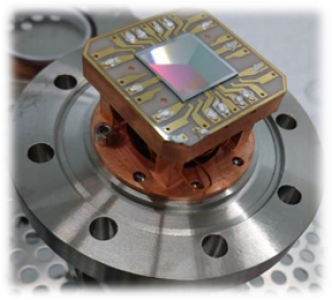Hybrid, grating-MOT + magnetic chip trap, approach to compact high frequency BEC production in space

The objective of this activity is first to develop a large single-input beam grating magneto-optical trap as a source of dense sub-Doppler cooled atoms and subsequently to load the ultra-cold atoms into a conservative 'dimple' magnetic chip trap, followed by evaporation to BEC.
Quantum degenerate gases such as Bose-Einstein Condensates (BECs) are key tools for ultimate precision quantum technologies in space. On earth, gravity prevents long measurement times except in experiments with prohibitively large footprints (10m), however in orbit or in deep space the chilliest terrestrial atomic clouds would take minutes to expand to a radius of 1cm which corresponds to 100km of ballistic free-fall. There has been strong progress recently in the development of portable high-rep-rate BEC devices, however such systems still rely on the optical complication and footprint of separate laser cooling systems each relying on three orthogonal sets of laser beams and associated beam conditioning optics. A new, complementary approach based on single-input-beam Grating-Magneto Optical Traps (G-MOTs) is required. The use of G-MOTs with Chip-BECs (C-BECs) combines two proven components into compact quantum technology. Laser cooled atomic samples have resulted in profound improvements in frequency metrology, however the technology is typically complex and bulky. Advances have been made in developing portable laser cooling apparatus, instilling the advantages of atoms in the micro-kelvin regime, as evidenced by on-going ESA projects in this area. However, simplifying the laser cooling procedures using micro-fabrication technology has, up to now, proved quite difficult. Micro-fabricated optical elements that greatly facilitate miniaturization of ultra-cold atom technology have recently been developed as part of a small ESA (TAS-TRP) project. Grating MOTs require only a single input beam-line, yet deliver 60 million cold Rb atoms from a cubic centimeter capture volume; comparable performance to an equivalent 6-beam trap and ten thousand times superior to prior micro-fabricated traps. Moreover, sub-Doppler temperatures can be reached in the same apparatus with similar total atom numbers, indicating the technology could be used for reaching high phase space densities ideal for creating quantum degenerate gases, by first loading e.g. a magnetic chip trap. With grating Magneto Optical Trap (MOT) technology, the number of atoms captured in the MOT scales like in a normal MOT, i.e. an order of magnitude more atoms if the beam size is doubled. Grating MOT technologies free up the requirements on optical access and optical beam-lines required in standard experiments and they will be combined with proven BEC chip technology to yield BEC machines with a much smaller final form factor, and lower complexity. The end goal of a fast repetition rate, large atom number BEC will have many applications, both terrestrial and in space, because the ultimate measurement times are achieved with the coldest and most compact of atomic sources.
